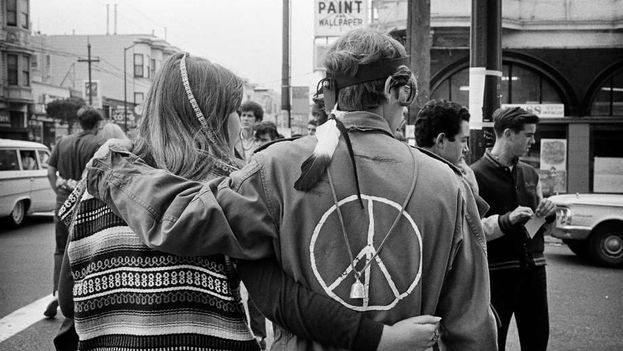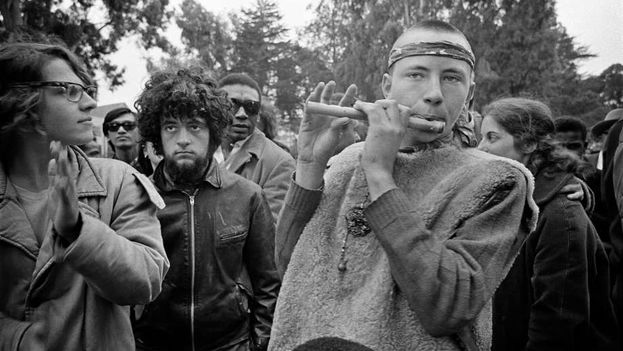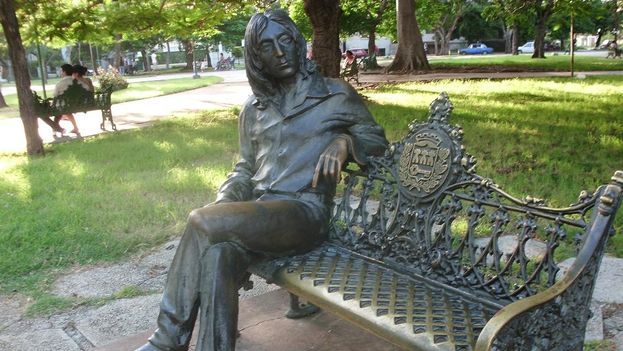
![]() 14ymedio, Ernesto Santana, Havana, 12 August 1917 — The year 1967 was crucial and socially and culturally very spirited, as demonstrated by the Summer of Love in San Francisco, California, which marked the beginning of the hippie movement in the United States. The epicenter was the Haight Ashbury, an urban area of two square miles which attracted thousands of young people from all over the country.
14ymedio, Ernesto Santana, Havana, 12 August 1917 — The year 1967 was crucial and socially and culturally very spirited, as demonstrated by the Summer of Love in San Francisco, California, which marked the beginning of the hippie movement in the United States. The epicenter was the Haight Ashbury, an urban area of two square miles which attracted thousands of young people from all over the country.
San Francisco was already a notable focus of the Beat Generation, whose greatest poet, Allen Ginsberg, was a sort of Golden Gate – a great bridge – between that generation and the new movement that made this great open city its mecca. The countercultural tsunami that began at that time, was felt throughout the world and its effects are still very difficult to measure objectively.
In fact, that Summer of Love began in January with the Human Be-in, a big event in response to the recent banning of the use of LSD, to which many artists and intellectuals who were leading the indefinable revolt were invited. The motto was “Leave your fears at the door and join the future.”
In June, the temperature rose still further with the Monterey Pop Festival. Meanwhile, hundred thousand young people from all over the United States and other countries descended on San Francisco’s Haight Ashbury neighborhood, giving shape to a ‘flower power’ garnished with psychedelic rock, free love, a lot of drugs and growing opposition to the Vietnam War. What was called the Age of Aquarius had begun.
In Monterey, several of the great contemporary musical leaders performed, including the The Who, The Animals, Jimi Hendrix, Jefferson Airplane, The Grateful Dead and Janis Joplin with Big Brother and the Holding Company, among others. The song written to promote the festival was San Francisco (Be Sure to Wear Flowers in Your Hair), sung by Scott McKenzie and written by John Phillips of the Mamas and the Papas, which became the hippie anthem. The San Francisco Chronicle baptized the event the ‘Summer of Love.’

But that warm, colorful, lysergic and loving season ended with many shadows as well. The media abuse, caricaturization and manipulation – turning it into a tourist attraction – was such that in October, as a controversial metaphor, the “Burial of the Hippie” was performed. Protagonists of the Summer of Love would end up dispersed in hippie communes and farms in areas around San Francisco.
The famous murderer Charles Manson would also be one of the undertakers of that flowery adventure. His stay in Haight Ashbury and his hippie aspect led to the macabre homicides of his tribe casting a shadow over the countercultural movement which, above all, celebrated life, love and peace.
However, the hippie tide left a legacy that still lingers in ecological consciousness, in a wide range of music, in opposition to war, in overcoming sexual prejudices, in defense of freedom of expression and civil rights, and even at the root of the rules of the World Wide Web. And the memory remains that, at least for a brief time, a utopia, an alternative society could be experienced.
Cuba and its eternal summer (not of love)
In our country, rock, since its arrival in 1956, promised to have a long, fertile and enriching life. When rock ‘n’ roll came to Havana – mainly through films such as Blackboard Jungle and Rock Around the Clock – there were frenetic dance moves in the movie theaters.
In 1967, the Beatles were the gods of a mass secret cult despite the fierce prohibitions of ideological commissars who watched with alarm the proliferation of combos and the growing sympathy of young people for the music of the Anglo-Saxon cultural empire. The hippies were sick, decadent, petty bourgeois: the antithesis of the New Man.
If those hairy people loved rock, peace and freedom, young Cubans had to settle for the Nueva Trova, national dance music and military hymns and marches. They must prepare to hate and kill the enemy designated by the Maximum Leader and his club of solitary hearts; they must obey blindly. Any doubt, any different individual opinion was ideological diversionism. The Military Units to Aid Production (UMAP) were already trying to straighten out the deviants before the Summer of Love.
A documentary of those years, Youth, Rebellion, Revolution, directed by Enrique Pineda Barnet, shows a meeting between Cuban students and those of other countries and illustrates the violent, intolerant and alienated spirit that many young people assumed at the time. The opinions expressed in the movie seem pathetic now, although the old commissars wish they were still in vogue.

“A hippie is a loser… hippies represent a stage of youth rebellion, a step towards politicization. Not in general, but of a part of those people,” say some voices in the film. “It’s an apolitical youth, already integrated into a system that is much more pernicious than hippies. Hippies are an ornament,” says another. “The revolutionary is the best artist of the 20th century,” says one of the boys.
A Latin American youth pontificates: “Protest art is sold like they previously sold romantic art. Within the protest there are lines: the yellow line of protest without cause, then there is the green line of those who preach peace and then there is the red line of those who really protest. Among the many signs, one prays: “The light of the dawn is before us. We must rise and act. Mao Zedong.”
In Cuba, just in case, John Lennon, apostle of that counterculture, is sculpted seated, his mouth closed, a friendly pose: a bronze statue that allows hundreds of tourists to sit next to him every day.
